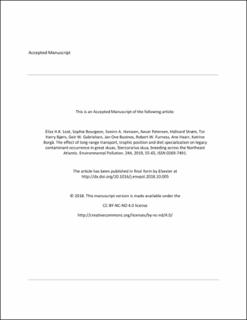| dc.contributor.author | Leat, Eliza Helen Kelsey | |
| dc.contributor.author | Bourgeon, Sophie | |
| dc.contributor.author | Hanssen, Sveinn Are | |
| dc.contributor.author | Petersen, Ævar | |
| dc.contributor.author | Strøm, Hallvard | |
| dc.contributor.author | Bjørn, Tor Harry | |
| dc.contributor.author | Gabrielsen, Geir W. | |
| dc.contributor.author | Bustnes, Jan Ove | |
| dc.contributor.author | Furness, Robert W. | |
| dc.contributor.author | Haarr, Ane | |
| dc.contributor.author | Borgå, Katrine | |
| dc.date.accessioned | 2020-07-08T10:40:46Z | |
| dc.date.available | 2020-07-08T10:40:46Z | |
| dc.date.created | 2018-10-17T12:52:56Z | |
| dc.date.issued | 2019 | |
| dc.identifier.citation | Environmental Pollution (1987). 2019, 244, 55-65. | en_US |
| dc.identifier.issn | 0269-7491 | |
| dc.identifier.uri | https://hdl.handle.net/11250/2661396 | |
| dc.description | Embargo until 08 October 2020 | en_US |
| dc.description.abstract | High levels of halogenated organic contaminants (HOCs) have been found in the marine predatory seabird great skua (Stercorarius skua) from breeding colonies in the Northeastern Atlantic, with large unexplained inter-colony variation. The present study aimed at analyzing if the HOCs occurrence in breeding great skuas in remote colonies was explained by local baseline food web exposure determined by long-range transport, or by ecological factors such as diet specialization and relative trophic position in the breeding area. The occurrence of organochlorine pesticides (OCPs), polychlorinated biphenyls (PCBs), and polybrominated diphenyl ethers (PBDEs) was analyzed in plasma of 204 adult great skuas collected over two years (2008 and 2009) and 5 colonies across the North-Atlantic from Shetland to Svalbard. The ΣHOCs levels in plasma ranged across two orders of magnitude, from 40 to 7600 ng/g (wet weight) and differed significantly across the great skua colonies. The variation in contaminant occurrence among colonies did not reflect long-range transport through a latitudinal or remoteness gradient, as the second northernmost colony (Bjørnøya), had the highest contaminant concentrations. No latitudinal or remoteness gradient was evident in the contaminant pattern among the colonies. The contaminant levels increased significantly with increasing δ15N values, and regurgitated pellets of undigested prey suggested that great skuas with higher δ15N values had a higher proportion of bird prey in their diet, mostly seabirds. In contrast, great skuas from colonies with lower δ15N and lower contaminant level fed mostly on fish. The enrichment of δ13C increased with decreasing δ15N and lower contaminant levels. Therefore, individual behavior of great skuas, such as migration strategies and diet specialization, rather than long-range transport and thus baseline food web exposure, explain among and within colony variance in contaminant occurrence. | en_US |
| dc.language.iso | eng | en_US |
| dc.publisher | Elsevier | en_US |
| dc.rights | Attribution-NonCommercial-NoDerivatives 4.0 Internasjonal | * |
| dc.rights.uri | http://creativecommons.org/licenses/by-nc-nd/4.0/deed.no | * |
| dc.title | The effect of long-range transport, trophic position and diet specialization on legacy contaminant occurrence in great skuas, Stercorarius skua, breeding across the Northeast Atlantic | en_US |
| dc.type | Peer reviewed | en_US |
| dc.type | Journal article | en_US |
| dc.description.version | acceptedVersion | en_US |
| dc.source.pagenumber | 55-65 | en_US |
| dc.source.volume | 244 | en_US |
| dc.source.journal | Environmental Pollution (1987) | en_US |
| dc.identifier.doi | 10.1016/j.envpol.2018.10.005 | |
| dc.identifier.cristin | 1621042 | |
| dc.relation.project | Norges forskningsråd: 184830 | en_US |
| cristin.unitcode | 7464,20,12,0 | |
| cristin.unitname | Marin forurensning | |
| cristin.ispublished | true | |
| cristin.fulltext | postprint | |
| cristin.qualitycode | 1 | |

